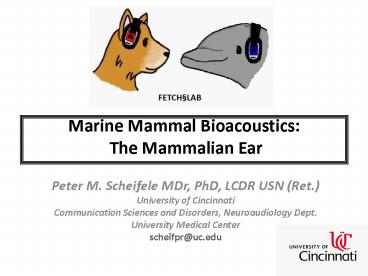Marine Mammal Bioacoustics: The Mammalian Ear - PowerPoint PPT Presentation
1 / 33
Title: Marine Mammal Bioacoustics: The Mammalian Ear
1
Marine Mammal Bioacoustics The Mammalian Ear
- Peter M. Scheifele MDr, PhD, LCDR USN (Ret.)
- University of Cincinnati
- Communication Sciences and Disorders,
Neuroaudiology Dept. - University Medical Center
- scheifpr_at_uc.edu
2
Auditory Pathway from the Outer to Inner Ear
(Anatomy Function)
Via CN-VIII
- Outer Ear
- (A) Pinnae
- (A) External Auditory Meatus
- (F) Collect and Direct
- (F) Vibrational Wave
- (F) Compression Refraction
Middle Ear (A) Ossicles (A) Tympanic Membrane (A)
Tympanum (A) Eustachian Tubes (F)
Mechanical Motion (F) Transfer Function Air to
Mechanical Impedance amplification
Inner Ear (A) Cochlea (A) Scala-media Organ of
Corti Basilar Membrane Hair Cells Endolymphatic
Fluid (F) Processes, samples frequency
intensity (F) Fluid wave motion
- Brain (CANS)
- CANS Medulla, Pons, Brain stem, A1 A2
- (A) Cranial Nerve VIII
- (A) Inner via spiral ganglia
- Brain via medulla cochlear nuclei
- (F) Discrimination
- (F) Localization
- (F) Processing/Perception
- (F) Integration
- (G) Electrical signal
ELECTRICAL SIGNAL
MECHANICAL WAVE
AIR WAVE
FLUID WAVE
3
OUTER EAR ANATOMY
- Pinna or auricle
- Collects and directs sound
- Primarily cartilage
- External auditory meatus and canal
4
OUTER EAR FUNCTION
- Interaural time difference
- Head-related transfer function
5
(No Transcript)
6
The Human Temporal Bone
7
MAMMALIAN MIDDLE EAR
- Increased activity level and metabolism
development of improved jaw mechanics - Foreshortened mandible
- Posterior bones became the ossicular chain
- Achieves its major advantage at higher
frequencies due to middle ear arrangement - Kangaroo rat (Dipodomys) has middle ear cavity
larger than its cranial cavity - Enhances low frequencies re predator avoidance
8
MAMMALIAN MIDDLE EAR
http//members.aol.com/tonyjeffs/text/dia.htm
9
Evolution of Ossicles in Mammals
- Mandibular joint not between quadrate and
articular bones - Now between dentary and squamosum
- Ancient reptilian bones evolved into mammalian
ossicles - Articulate bone became malleus
- Quadrate bone became incus
- Stapes evolved from hyomandibular bone (dentary)
- Mammals retain a form of jaw hearing
10
.
The Human Ear Model
11
The Canine Temporal Bone
12
Avian Anatomy
13
Inner Ear
14
Inner Ear Bony and Membranous Labyrinth
Bony Labyrinth - channels in temporal bone filled
with perilymph (continuous with CSF) - 3
regions vestibule, cochlea, and semicircular
canals Membranous Labyrinth - series of
membranous sacs and ducts within the bony
labyrinth filled with endolymph
15
Mammalian Cochlear Anatomy
- Scala
- Vestibuli
- Media
- tympani
- Basilar Membrane
- Reiseners Membrane
- Modiolis
16
The Cochlea in-general
- The actual organ of hearing
- Organ of Corti
- CN VIII
- Cochlear turns vary by organism
- Organ of Corti
- OHC
- IHC
17
Cochlear Duct (Scala Media)
- Separated from scala vestibuli by vestibular
membrane - Ionic barrier between perilymph and endolymph
- Separated from scala tympani by osseous spiral
lamina and basilar membrane - Organ of Corti sits on top of the basilar
membrane - Stereo-cilia project from the basilar membrane to
the tectorial membrane
18
The Cochlea
A spiral, bony chamber extending from the
anterior vestibule - contains the cochlear
duct The cochlear duct contains the organ of
Corti (hearing receptor)
19
Cochlear Anatomy
Image from http//www.boystownhospital.org/BasicC
linic/neuro/cel/Inside_Cochlea.asp
20
The Cochlea
21
Cochlear Comparisons
22
Avian Cochlear Anatomy
Source ww.bio.purdue.edu/Bioweb/People/Faculty/it
en.html
Source http//www.palaeos.com/Vertebrates/Bones/E
ar/Overview.html
23
Resonance of the Basilar Membrane
24
The Traveling Wave Tonotopic Organization
From Yost
25
The Organ of Corti
26
The Organ of Corti
Composed of supporting cells and outer and inner
hair cells, afferent fibers of the cochlear nerve
attach to the base of the hair cells The
stereocilia (hairs) protrude into the endolymph
and touch the tectorial membrane
Bending the cilia opens mechanically gated ion
channels which causes a graded potential and the
release of a neurotransmitter (probably
glutamate) The neurotransmitter causes cochlear
fibers to transmit impulses to the brain
27
Hair Cells
28
Healthy human ear
High frequency loss Trauma
Photos Natl. Hearing Conservation Assn.
29
Metabolic mitochondria lytic mixing
Mechanical stereocilia/plate hair cells/organ of
Corti membranes
Lim in Schuknecht, 1993
30
Cochlear Portion of CN-VIII
- Afferent neurons of CN-VIII
- Bi-polar cell bodies
- Spiral ganglion in modiolus
- End-point is dorsal ventral cochlear nuclei
- Efferent neurons
- From dorsal nucleus of trapezoid body
- To dendrites of afferent neurons of OHCs
- Purpose tuning
31
The Hearing Threshold Curve
From Yost
32
Graphical Hearing Descriptors
Audiogram
Hearing Threshold Curve
33
fini































